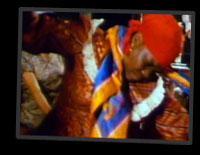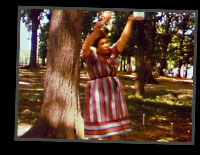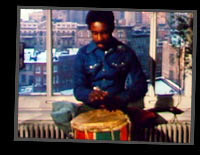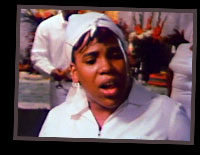
Legacy of the Spirits 1985, 52 mins.WNYC RADIO INTERVIEW BEHIND THE SCENESWNYC: With us in our NYC studio today is Karen Kramer, the director of LEGACY OF THE SPIRITS which depicts the lives of practitioners of Vodou in New York City, and also tries to dispel some of the myths around that, because Vodou has a bad name. I think we should begin with the idea of filmmakers getting the kind of trust that must be necessary to go into sacred rituals, into places where people speak different languages, and have a whole different kind of mind set, and be able to film things of this sort. Is it as different as I imagine it must be? Karen, you filmed this in New York City. Does that make it any easier?
KK: The actual act of filming in New York is easier than other places I’ve filmed such as Appalachia and the Caribbean because I live here. But because of the subject matter it was very very difficult to film. It took 5 years to be able to do this film simply because the religion itself is so underground and has always been kept underground. I’d been going to Vodou ceremonies for at least 3 years before I ever thought of doing a documentary. I was always amazed at the beauty of the ceremonies.  WNYC: You were going as an anthropologist? KK: I’m not an anthropologist, I’m a filmmaker. And I’d done some films in Haiti and I’d been to several Vodou ceremonies. And I had several Haitian friends in New York who would go, and I began going just because I had a deep satisfaction in attending. I find the ceremonies themselves very interesting and very beautiful, and I was just going from personal interest. But I found that whenever I would tell (non-Haitian) friends that I was going they would look panic-stricken and say that I had to be careful and did I know what I was getting into? They had the same horrible stereotypes that most people had about the religion. And the more this kept happening, I realized that somebody had to do a documentary about this to show the religion for what it really is, because there’s a lot of complexity to it and the stereotype should be broken. At first, I didn’t want to be the one to do this film, because I knew it would be a very difficult film to make. But I needed to show and explain the amazing beauty and sophistication behind this belief system. WNYC: You’re white, you’re not French-speaking. How were you treated as an outsider? KK: I never had any trouble attending the ceremonies. I was pretty much welcome wherever I went. I’ve been to about 25 different houses in New York and wherever I went I was made to feel welcome. There are 3 houses that I attend in particular. But the idea of filming brought a lot of challenges and initial resistance. Everyone thought that the idea of doing a film was wonderful but they didn’t want to be the ones filmed. There’s a tremendous amount of stereotyping against the people who are with this religion because of a lot of historical reasons. So they all said to me to do the film. But to do it using other people on camera. And it took a long, long time to convince people to be in the film. Finally what happened is that some of the younger, college-age people in the religion felt that it was time to come forward and stop being afraid of what people would say and to be proud of what they were doing. So finally we were able to film. But the filming took a long time because at the last minute people would drop out or have second thoughts about it.  WNYC: Is there a secrecy factor in this…a factor that if secrets or the religion are revealed on film that they’ll undermine the faith?
KK: Mostly the only thing that is secret is the initiation, and that goes on behind closed doors. Only people who have already been initiated are allowed to see it. I wasn’t after things like that anyway….I didn’t want to film anything that was private. WMYC: Could we assume that most Haitians in New York are believers if not practitioners? KK: We really don’t have any numbers. And then there’s the question of what it means to practice. Some people go to ceremonies all the time but are not very devout in their private life. And then you can find just the opposite: people who are very devout but don’t attend services. It’s like any religion. But I also want to say that it’s not only Haitians who are serviteurs. There are people from different parts of the Caribbean and many Americans as well…black and white. WNYC: It was founded in Haiti in much the same way that Santeria in Cuba and Macumba in Brazil. I know that these African religions involve synthesis; they merge with Catholicism as a way of fooling the slave owners. Is that true in Vodou as it is in Macumba? KK: It’s very true in Vodou. There’s a big Catholic influence and there is a connection between the Catholic saints and the African or Haitian deities called lwa. For example, there’s a Vodou spirit called Damballah who is a serpent. Now when the Catholic missionaries came to Haiti they began talking about St. Patrick driving the snakes out of Ireland. And they showed these pictures of St. Patrick to the slaves, and the slaves latched onto the fact that there were snakes in the pictures, and made the connection between their god, Damballah and St. Patrick. So now even today Damballah is always worshipped, or served on March 17, the day of St. Patrick. He is served throughout the year as well and this is the same for all the spirits. They all have a counterpart.  WNYC: Is there a specific part from Africa that Vodou comes from? By the way is it called Vodou? KK: It is called “vu-DU” which is an African word. And it comes from the Fon people of Dahomey – now called Benin – in West Africa. And the Fon word “vu-du” simply means spirit. WNYC: Is much of Vodou similar to aspects of Macumba? KK: Well, there’s a great similarity in many of the African-based religions that made it to the new world. When you were talking before you mentioned the Macumba spirits called “ibejis” which are the child spirits. In Vodou we have the same thing but they are called Marassa. There’s also a lot of basic similarities in the origins of the religions, in the way they’ve survived, and of having to take on Catholicism as a cover-up. I think that one of the reasons that Vodou has been able to survive and last is that it’s a very adaptable religion. It’s not strict and rigid. WNYC: Can we talk about animal sacrifice. KK: Most of the animal sacrifice I’ve seen here deals with chickens. When I was in Haiti in the countryside most every ceremony revolved around the animal offering. It’s a tremendous gift for a poor peasant to give to his lwa. When an animal is sacrificed the meat is eaten by all the people present, and certain parts of the animal are left for the spirit. So people are not just being wasteful because they eat the meat as well. It’s a very sacred act. WNYC: But not everyone understands this. KK: They don’t understand it, no. But when you understand it and you see that it really is an important part of the religion, and is not done haphazardly, then it’s really a beautiful part of the ritual. WNYC: Is there a heavy use of trance in Vodou? KK: Oh yes, there’s definitely a type of trance which is spirit possession. WNYC: We see trance in fundamentalist Christian sects, people who are possessed by the Holy Ghost. Is it basically the same process? KK: A few years ago I did a film on, and lived with, snake handlers who are very similar to Holy Rollers. They have their religious services where they dance and play music, and handle snakes, and they lay hands on the sick to heal them. And they definitely feel the Spirit. And when they’re in a trance state I think there’s a lot of similarities between them and people in Haiti, Cubans in New York, etc. I think that trance is universal. You see it with the Eskimos in the arctic who have their drum dance, you see it in Bali. The Hopi have it. I think that many cultures have rituals that involve trance. WNYC: When the spirit takes over a person is there a visual difference? If you’re watching them do you know when a person is filled with the spirit? KK: Usually you do. There’s a very dramatic difference. It depends on who the spirit is. If the spirit is a very calm kind of quiet spirit sometimes you don’t even know, and you could go up to the person and think you’re talking to a human being and you’ll get no response because it’s really the deity who’s come down. But most of the time you can really see. Also, in the ceremony you will be calling a certain spirit so when a spirit manifests you can assume it’s the one you’ve been calling. WNYC: There’s another thing I want to get into a little more. That is the presence of the filmmaker at the ceremony. Did you try to limit it to as few people as possible? I imagine that a huge film crew would feel really intrusive. KK: As I mentioned at the beginning, we had enormous obstacles about doing the film. Nobody wanted to be on camera at all. And before I even began filming ceremonies I started out with a very basic small crew and we were doing simple interviews on camera. It was just myself and a cinematographer and a soundman. I found that even that was too much. It became too much on many levels. Sometimes people wouldn’t show up for shoots and I would have to pay the crew anyway. And I was concerned that people might feel uncomfortable with three of us there even though, as you know, that is a tiny number for a film crew. So I scaled down even more, to the point where I did all the shooting and my friend did the sound recording. So we were really just a two person crew and we were very flexible and we would hang out with people before and after each shoot and that was a lot easier. The ceremonies, which were more complicated, were filmed years after I did the interviews, which were easier to obtain. When the people finally agreed to let me film the ceremonies I was concerned that once we set up the lights they might feel uncomfortable. I set everything up the night before, used film light bulbs screwed into household lamps, tried to keep everything low key. After the first few minutes they totally forgot about us, and it was as if we weren’t there. I think that really had to do with the fact that we worked very small, had a small crew, and worked with simple equipment. Kept it as low key as possible. An anthropologist had warned me that even if we ever got permission to film a ceremony that none of the spirits would appear, no one would get possessed. But that couldn’t have been more wrong. Many people got possessed whenever I filmed. WNYC: Well, the film sounds exciting and I look forward to seeing it. That’s at the Margaret Mead Festival at the Museum of Natural History. Thank you very much, Karen KK: Thank you.
back to top |